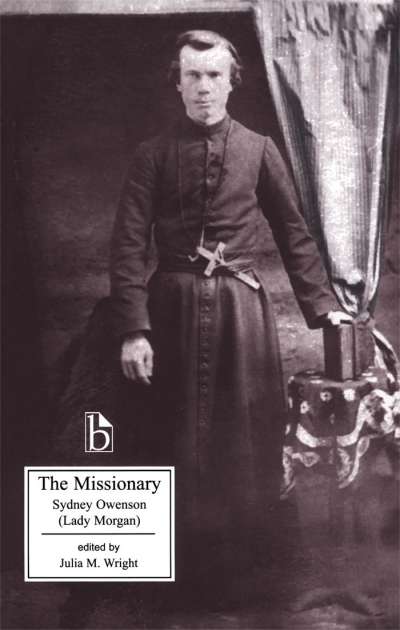Castle Rackrent—Maria Edgeworth’s first novel, and the work for which she was and is best known—occupies a most unusual place in the history both of Irish literature and of English-language fiction. It has sometimes been called the first historical novel in English literature, yet in its tone it more closely resembles a comedy of manners than anything in the genre that has come to be known as “the historical novel.” It has been identified as the first of other lines as well—the first English novel written in a non-standard dialect, the first “provincial” or “regional” novel, and the first in what developed into the “big house” tradition of novels focused on the lives of the Anglo-Irish Protestant landholding class that dominated much of Ireland for centuries. Its innovative use of an unreliable narrator makes it also, arguably, an important milestone in the development of the novel form as a whole.
Castle Rackrent chronicles the declining fortunes and ultimate ruin of the Rackrent family through the mishandling of their estate by a series of incompetent and irresponsible heirs.
Edgeworth attested in a letter she wrote years later that “the only character drawn from the life” in the novel is Thady Quirk (servant to the Rackrent family, and the novel’s narrator). But the novel as a whole is grounded in real events—the careless landlords and the “middle men who grind the face of the poor” described in Edgeworth’s fiction were very real in eighteenth-century Ireland.
This edition does more than any other to set this classic novel in the political, economic, and religious context of eighteenth- and early nineteenth-century Irish life; in addition to an illuminating introduction, the edition includes a variety of background historical materials.
Comments
“This new edition of Maria Edgeworth’s best-known fiction of Irish life will be warmly welcomed. A lively and informative introduction sketches Edgeworth’s life and times, and outlines the central questions posed by this witty philosophical tale. A skillfully accomplished summary of the historical and political background to the novel is followed by useful selections from contemporary sources, including Arthur Young’s scathing exposé of corrupt landlordism, and Theobald Wolfe Tone’s ‘Argument on Behalf of the Catholics of Ireland,’ a polemic that does much to show how the 1798 United Irishmen uprising emerged out of the exploitation identified by Young. Other extracts from contemporary documents focus on the misgovernment by the Anglo-Irish Protestant ascendancy echoed in Edgeworth’s tale of chaotic local tyrants. This edition is a valuable resource both for students of Edgeworth and general readers encountering her, and eighteenth-century Irish life, for the first time.” — Susan Manly, University of St Andrews
“The introduction to Broadview’s welcome new edition sets the novel in the context of Edgeworth’s career and its subsequent reception. The ‘In Context’ section furnishes the reader with contemporary reviews and texts from the times concerning Irish social and political conditions, particularly relating to the 1798 rebellion which led to the legislative union.” — Professor James H. Murphy, Director of Irish Studies, Boston College
“This valuable new edition sets the book in its historico-political context with excerpts from influential works by contemporary authors…. Edgeworth’s work is so valuable because it traverses the obvious faultlines in Irish political and social life. Helpfully, the edition also includes excerpts from reviews at the time of its publication, demonstrating how the meaning of Edgeworth’s novella continued to be interpreted and reinterpreted in so many different ways.” — John Bew, Professor of History and Foreign Policy, King’s College London
“The introduction provides a concise overview of Edgeworth’s critical neglect and literary merit as well as clearly outlining the challenges of reading a novel of ‘Irish’ manners by an Anglo-Irish writer. The contextual materials invaluably elucidate the political and economic injustices faced by the Irish as well as the English and Anglo-Irish prejudices justifying the continued religious and cultural oppression of the Irish people.” — Robin Runia, Xavier University of Louisiana
“As Walter Allen pointed out in his history of the English novel, Castle Rackent is to Irish literature what Huckleberry Finn is to American literature. This is a fine edition of a classic of the novel in English literary tradition.” — Maureen O. Murphy, Hofstra University
“Edgeworth’s Castle Rackrent has always been a strange little novel, a tale of the dissolution of the Rackrent family through their own mismanagement and irresponsibility, told in non-standard dialect by the illiterate Irish steward Thady Quirk. … [T]his welcome edition for the classroom provides an additional layer of useful glosses and illuminating contextual readings.” — Susan Egenolf, Texas A&M University
“Though Castle Rackrent is surely one of the shortest novels of its era—certainly in comparison with typical eighteenth- and nineteenth-century door-stoppers—it is also one of the most important, touching on a huge range of issues including British and Irish nationalism, colonial power, marriage and sexuality, religion and its obligations, property ownership, revolution and rebellion. It is also laugh-out-loud funny: Thady Quirk is one of the great unsung narrators of literary history. Julie Nash and her colleagues are to be commended for providing just the right amount of commentary and contextual material to keep any literature class interested and engaged. This is a welcome addition to the Broadview Anthology of Literature and to Broadview’s impressive lineup of Romantic-period editions.” — Alexander Dick, University of British Columbia
“This richly informative new edition of Maria Edgeworth’s ironic masterpiece approaches Castle Rackrent in terms of the questions that it still poses. The book supplies a wide array of contextual material, prompting new connections and allowing readers to come to their own conclusions. Students are sure to be drawn to the portfolio of images of Irish housing that accompanies the text. Truly an edition to explore and enjoy.” — Claire Connolly, University College Cork












